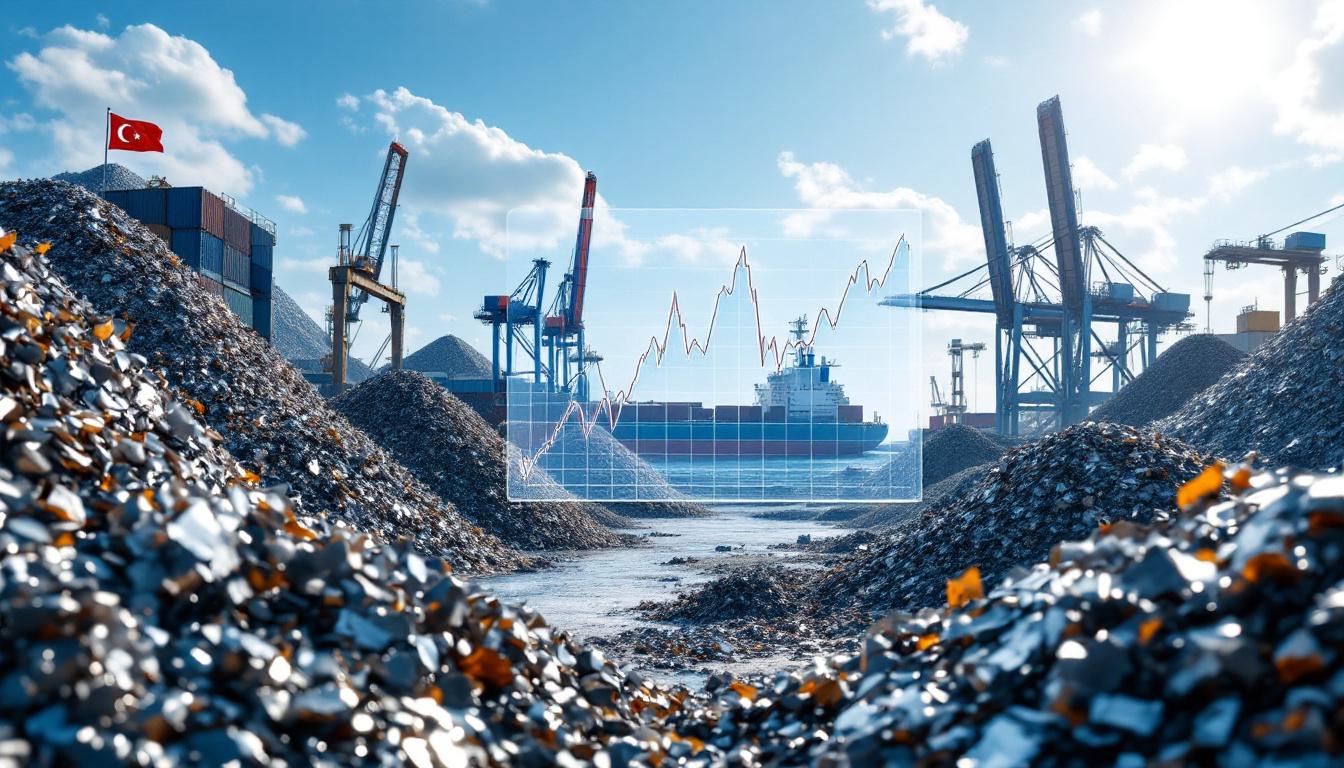How Does the Gold Price Impact Tailings Reclamation Projects?
The relationship between gold price and tailings reclamation projects is both complex and direct. When gold prices rise significantly—as we've seen with recent increases to over $2,300 per ounce—previously uneconomical tailings deposits suddenly become viable mining opportunities. This price movement transforms environmental liabilities into potential assets.
A critical factor for investors to understand is the magnified impact of gold price fluctuations on tailings operations. According to Neil Pretorius, CEO of DRD Gold, "A 3% movement in the gold price can result in 7-11% stock price movements for companies in this sector." This sensitivity stems from the unique cost structure of tailings processing operations.
Recent market volatility demonstrates this relationship clearly. In May 2025, the gold market experienced a 5% gain on Friday, followed by a 3% drop the following Monday after news of potential geopolitical resolutions, resulting in substantial swings for tailings reclamation companies.
The Economics of Reprocessing Tailings
Tailings reclamation projects typically operate on thinner margins than traditional mining operations due to:
- Lower gold concentration (already processed once)
- Higher processing volumes required
- Significant infrastructure investments
- Environmental remediation costs
However, when all‐time high gold prices occur, these projects can become remarkably profitable while simultaneously addressing environmental concerns. DRD Gold's record financial results in H1 2025 exemplify this dynamic, with the company achieving exceptional performance despite reduced throughput due to wet weather during summer months.
Industry analysts have taken notice of this potential, with one prominent South African analyst revising their gold price forecast from $2,300 to $3,200 per ounce, highlighting the transformative impact on tailings operations.
Gold Price Volatility and Investment Decisions
Recent market volatility has demonstrated how quickly sentiment can shift in the gold sector:
| Time Period | Gold Price Movement | Market Reaction |
|---|---|---|
| Friday | +5% gain | Positive investor sentiment |
| Weekend | News of potential geopolitical resolutions | Market uncertainty |
| Monday | -3% price drop | 7-11% losses for most gold stocks |
Despite this volatility, the overall gold price trend remains significantly higher than historical averages, supporting long-term investment in tailings reclamation infrastructure.
A distinctive aspect of companies like DRD Gold is their approach to gold price risk. Most tailings processors choose an unhedged strategy, taking full exposure to gold price movements. As Pretorius explains, "We don't hedge. We take full exposure to gold price movements." This approach maximizes upside potential during favorable price environments while requiring operational discipline to weather downturns.
What Makes Tailings Reclamation Different From Traditional Mining?
Tailings reclamation represents a fundamentally different approach to gold mining compared to traditional underground or open-pit operations. This distinction goes beyond operational differences to encompass environmental impacts, risk profiles, and business models.
Environmental Benefits of Tailings Reclamation
Tailings reclamation offers several environmental advantages:
- Waste neutrality: No new mining waste is generated
- Land rehabilitation: Previously contaminated areas are restored
- Modern environmental standards: Old tailings are relocated to facilities built to current regulations
- Ecosystem restoration: Sites can be returned to their natural state or repurposed
These benefits create a compelling sustainability narrative. As Pretorius emphasizes, "The business is waste neutral. We take old waste, reprocess it, and store it in modern facilities." This approach aligns with UN Sustainable Development Goal 15 (Life on Land) through active land restoration.
Operational Differences
The operational profile of tailings reclamation differs significantly from conventional mining:
- Surface-only operations: No underground mining risks (seismicity, falls of ground)
- Known resources: The material has already been mined and deposited
- Predictable grades: While variable, the tailings composition is more consistent than unexplored deposits
- Infrastructure-focused: Success depends on processing efficiency rather than exploration
- Factory-like production: Once established, operations function more like industrial processing plants
DRD Gold's Ergo project exemplifies this model, processing approximately 1.6 million tons of tailings material monthly while simultaneously rehabilitating the land from which tailings are removed.
Financial and Risk Profile
Tailings reclamation presents a unique financial profile:
- Lower capital intensity for expansion (existing infrastructure)
- Reduced geological risk (resource already identified)
- Smaller "stay-in-business" capital requirements (approximately 5% of operating costs)
- Different closure liabilities compared to conventional mining
- Full exposure to gold price movements (typically unhedged)
The infrastructure-focused nature of tailings reclamation creates what Pretorius describes as "a factory processing a stockpile." This model shifts the focus from exploration and development to processing efficiency and technological optimization.
How Are Companies Extending the Life of Tailings Reclamation Projects?
Extending the life of tailings reclamation projects requires strategic planning and capital investment. Companies like DRD Gold have implemented multi-faceted approaches to transform short-term projects into multi-decade operations.
Case Study: Ergo Operations Extension
The Ergo operation provides an instructive example of life extension strategies:
- Original plan: 12-year life of mine
- Current projection: Operations extended beyond 2040
- Key investment areas:
- 60-megawatt solar power plant
- 180-megawatt battery energy storage system
- New tailings storage facilities
- Pipeline network expansion
- Processing plant optimization
This extension strategy demonstrates how tailings processors can think beyond traditional mining timeframes. By investing 2.9 billion ZAR (approximately $160 million) in solar infrastructure alone, DRD Gold has fundamentally extended the economic viability of its operations.
Renewable Energy Integration
Energy costs represent a significant portion of operating expenses for tailings processing. Investments in renewable energy provide multiple benefits:
- Reduced operating costs
- Increased operational resilience
- Improved environmental performance
- Protection against electricity price inflation
Pretorius highlights the strategic value of these investments: "Investing in solar and battery storage reduces operating costs and insulates against energy inflation." This approach aligns with broader industry trends, with mining companies increasingly adopting renewable energy solutions to address both cost and sustainability concerns.
Processing Capacity Expansion
Increasing processing capacity allows for:
- Higher throughput (millions of tons monthly)
- Optimized blending of different grade materials
- Extended project life through processing lower-grade materials
- Improved economies of scale
DRD Gold's Far West Gold Operations showcases this strategy, expanding from 500,000 to 1.2 million tons monthly processing capacity. This expansion enables the economical processing of lower-grade material that would otherwise remain unprocessed.
What Are the Financial Considerations for Tailings Reclamation Projects?
Tailings reclamation projects operate under different financial parameters than traditional mining operations, requiring specialized analysis and investment approaches.
Capital Allocation Strategy
Successful tailings reclamation operations balance several financial priorities:
- Capital reinvestment: Building infrastructure for long-term operations
- Dividend payments: Maintaining shareholder returns (typically 2.5-5% yield)
- Operational flexibility: Maintaining capacity to weather gold price fluctuations
- Environmental provisions: Funding for rehabilitation and closure
DRD Gold's approach exemplifies this balance, maintaining a consistent dividend yield between 2.5-5% for 18 years while simultaneously investing in major infrastructure projects like their 2.9 billion ZAR solar plant.
Production Economics
The economics of tailings reclamation are driven by:
- Volume processing: Success depends on efficiently moving and processing massive quantities of material
- Blending strategy: Mixing higher and lower grade tailings to optimize recovery
- Recovery efficiency: Extracting maximum value from already-processed material
- Infrastructure utilization: Maximizing the use of established plants and pipeline networks
This volume-driven approach differs fundamentally from traditional mining's grade-driven economics. While conventional miners might focus on high-grade zones, tailings processors must maximize throughput efficiency across large volumes of relatively homogeneous material.
Long-Term Financial Planning
Financial planning for tailings reclamation extends decades into the future:
- Resource optimization: Planning to process the entire resource rather than "high-grading"
- Infrastructure investment timing: Building during strong gold price environments
- Closure planning: Progressive rehabilitation reduces end-of-life liabilities
- Dividend sustainability: Maintaining consistent returns through price cycles
The extended timeframe of these projects—with DRD Gold planning operations beyond 2040—requires a uniquely long-term perspective compared to conventional mining operations, which often operate on 5-10 year planning horizons.
How Do Environmental Responsibilities Shape Tailings Reclamation?
Environmental considerations are central to tailings reclamation projects, not merely regulatory requirements but fundamental aspects of the business model.
Rehabilitation During Operations
Unlike conventional mining, tailings reclamation incorporates rehabilitation throughout the operational phase:
- Areas where tailings are removed are progressively rehabilitated
- Land can be returned to natural state or repurposed for other uses
- Environmental improvements occur simultaneously with gold production
This progressive approach to rehabilitation represents a significant advantage over traditional mining, where rehabilitation typically occurs primarily after operations cease. As Pretorius notes, "We remove historic contamination and restore ecosystems" throughout the operational phase.
Modern Tailings Management
New tailings storage facilities incorporate advanced design features:
- Synthetic liners to prevent groundwater contamination
- Center-line downstream dam construction for improved stability
- Modern monitoring systems
- Designed for eventual closure and rehabilitation
These technical standards reflect significant advances in tailings management practices, addressing concerns raised by high-profile tailings dam failures in the broader mining industry. The emphasis on modern containment technologies ensures that reprocessed material is stored more safely than in its original state.
Closure Liability Management
While closure liabilities exist, they differ from conventional mining:
- Provisions required for potential premature closure
- Financial guarantees maintained for rehabilitation funding
- Significantly reduced liability once project is completed
- Progressive rehabilitation reduces end-of-life costs
DRD Gold maintains "several hundred million ZAR" in guarantees for closure liabilities, ensuring financial resources are available for rehabilitation regardless of the company's future financial status. This approach addresses regulatory requirements while aligning with stakeholder expectations for responsible closure planning.
What Role Does Corporate Culture Play in Sustainable Mining?
The success of tailings reclamation projects depends heavily on organizational culture and governance approaches that prioritize sustainability and long-term thinking.
Leadership Consistency and Values
Companies succeeding in this space often demonstrate:
- Board and executive stability
- Consistent application of values
- Focus on purpose beyond quarterly results
- Alignment between corporate and personal interests
- Space for values to become deeply embedded
DRD Gold's leadership transition from Jeff Campbell to Tim Sneller demonstrates this continuity, maintaining consistent values while adapting to changing market conditions. This stability enables the long-term thinking required for multi-decade tailings projects.
Workforce Development
The human element is crucial for sustainable operations:
- Attracting younger generations to the mining sector
- Increasing gender diversity (approaching 50% female representation)
- Technical skills development across disciplines
- Creating ownership mentality among employees
- Building purpose-driven culture
DRD Gold's achievement of approximately 50% female representation stands out in an industry traditionally dominated by men. This diversity brings fresh perspectives to operational and strategic challenges while helping address the mining sector's persistent skills gap.
Long-Term Perspective
Sustainable tailings reclamation requires thinking beyond typical mining timeframes:
- Planning horizons extending 20+ years
- Commitment to complete resource processing (not just high-grade portions)
- Balancing short-term profitability with long-term sustainability
- Creating lasting positive impacts on previously mined landscapes
Pretorius highlights the importance of purpose in maintaining this perspective: "Purpose beyond oneself drives our long-term thinking." This values-based approach supports the patience required to develop and execute multi-decade projects.
What Does the Future Hold for Gold Tailings Reclamation?
The future of gold tailings reclamation appears promising as environmental standards increase and gold market analysis shows continued strength. Several trends are emerging:
Production Growth Potential
Companies in this sector are targeting significant production increases:
- Processing capacity expansions (millions of tons monthly)
- Improved recovery technologies
- Target production approaching 200,000 ounces annually
- Extended project lives (beyond 2040 in some cases)
DRD Gold's target of producing 200,000 ounces annually by 2028 demonstrates the growth potential in this sector, even from a single operator focused on a specific geographic region.
Technology Integration
Technological advancements are improving the economics of tailings reclamation:
- Renewable energy: Solar power and battery storage systems
- Advanced processing: Improved recovery from lower-grade materials
- Automation: Increased efficiency and reduced costs
- Environmental monitoring: Better management of environmental impacts
The integration of 60-megawatt solar capacity with 180-megawatt battery storage represents just one example of how technology is fundamentally reshaping the economics of tailings reclamation. These innovations simultaneously reduce costs and environmental impacts, creating a virtuous cycle of improvement.
Industry Expansion Potential
Despite the clear benefits, relatively few companies specialize in tailings reclamation. Expansion opportunities exist:
- Thousands of legacy tailings sites globally
- Increasing regulatory pressure for remediation
- Growing investor interest in environmentally positive mining
- Potential for technology transfer to other mineral recovery
With over 1,000 legacy tailings sites worldwide, the opportunity for industry expansion remains substantial. The combination of environmental benefits, mine reclamation innovation and favorable record high prices as inflation hedge creates compelling conditions for growth in this specialized sector.
FAQs About Gold Price and Tailings Reclamation
How do gold price fluctuations affect tailings reclamation economics?
Gold price fluctuations have a magnified impact on tailings reclamation projects due to their typically higher cost structure. A 3% movement in gold price can result in 7-11% stock price movements for companies in this sector. However, the current elevated gold price environment (above $2,300/oz) provides substantial margins even for higher-cost producers.
Disclaimer: Gold prices are subject to significant volatility. Past performance does not guarantee future results. Investors should consult financial advisors before making investment decisions based on gold price projections.
What environmental benefits does gold tailings reclamation provide?
Gold tailings reclamation provides multiple environmental benefits including:
- Removal of historic sources of potential contamination
- Rehabilitation of previously disturbed land
- Proper containment of processed materials in modern facilities
- Reduction of long-term environmental liabilities
- Potential for land reuse after project completion
These benefits align with UN Sustainable Development Goal 15 (Life on Land) through active ecosystem restoration and land rehabilitation.
How do tailings reclamation companies manage gold price risk?
Many tailings reclamation companies choose not to hedge their gold production, taking full exposure to price movements. This approach maximizes upside potential during strong price environments while requiring operational discipline and financial conservatism to weather downturns. Companies typically maintain strong balance sheets and focus on infrastructure investments during favorable price periods.
DRD Gold exemplifies this approach, maintaining an unhedged position while investing in infrastructure that reduces operating costs, effectively creating operational leverage to gold price movements.
What determines the economic viability of a tailings reclamation project?
Economic viability depends on several factors:
- Gold content in the tailings material
- Processing costs (energy, labor, reagents)
- Infrastructure requirements (pipelines, processing plants)
- Environmental remediation costs
- Gold price environment
- Regulatory requirements
- Available technology for efficient recovery
The interplay between these factors creates a complex calculation that varies significantly between projects. Higher gold prices expand the universe of economically viable tailings deposits by allowing for the processing of lower-grade materials.
How does tailings reclamation compare to traditional gold mining in terms of sustainability?
Tailings reclamation generally offers superior sustainability characteristics compared to traditional mining:
- No new land disturbance required
- Remediation of existing environmental issues
- Lower energy and water intensity per ounce produced
- Reduced waste generation
- Smaller physical footprint
- Progressive rehabilitation throughout project life
This sustainability advantage creates potential for preferential treatment from ESG-focused investors and favorable regulatory consideration, particularly as environmental standards for mining continue to increase globally.
Want to Profit from the Next Major Mineral Discovery?
Stay one step ahead of the market with Discovery Alert's proprietary Discovery IQ model, which instantly identifies significant ASX mineral discoveries and transforms complex data into actionable investment opportunities. Explore why major mineral discoveries can lead to substantial returns by visiting our dedicated discoveries page and begin your 30-day free trial today.




